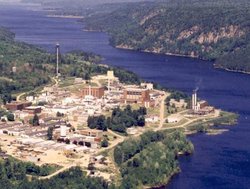Chalk River, Canada
Chalk River, Ontario, Canada (46° 3' 0.87" N, 77° 21' 39.61 W) is the site of a nuclear research facility where a nuclear power reactor experienced a serious nuclear accident on December 12, 1952.
Canada’s National Research Council (NRC) founded the Chalk River Laboratories on Chalk River to research the production of nuclear material for atomic weapons during World War II, and to investigate nuclear power generation. The NRC's experimental reactor, named NRX, began operation on July 22, 1947. The NRX, a 42-megawatt reactor, produced nuclear power from 1947-1993 and was one of world’s most powerful research reactors.
The accident occurred when an operator of the NRX reactor mistakenly opened four valves that served to keep air pressure from reaching the control rods. As a result, air pressure from above was reduced, and air pressure from below caused three or four control rods to rise out of the reactor.
Attempts by the supervisor to stop the reaction and prevent further damage actually compounded the problem when he made the mistake of instructing the operator to push the wrong button. With a number of control rods only partially in place, the raising of the safeguard bank of rods caused the power output of the reactor to double every 2 seconds, according to later investigation. Approximately three minutes after these errors occurred, the four-ton lid of the reactor blew off releasing radioactive water. The nuclear accident ended with a hydrogen-oxygen explosion in the calandria tubes of the reactor.
In order to cool the reactor, the ordinary water cooling system was kept in operation. All of this water was radioactive, and it leaked out onto the floor of the reactor building. Within a few days, the water was one meter deep and had spilled into the gas holder's room and the two rooms containing the heavy water storage tanks. A one million liter tank of clean water was emptied into the Ottawa River and the tank was then refilled with the contaminated water. In total, some 4.5 million liters of water were involved. To avoid having the water reach the Ottawa River, a pipeline was built to a sandy area about 1,600 meters away. The contaminated water, containing about 10,000 curies of long-lived fission products, was pumped to this area and allowed to slowly seep away. Monitors were established at the first two water intakes downriver, 22 and 37 kilometers away, and observations showed no radioactivity above the natural level.
Decontamination and cleanup lasted several months. Jimmy Carter, then a nuclear engineer in the US Navy, participated in the cleanup crew for the nuclear accident. The calandria was removed, buried and replaced with a new one and NRX was back in service within two years.
Fortunately, no deaths or serious injuries occurred as an immediate result of the accident. Although some personnel were exposed to high radiation levels during the accident, a 1982 follow-up study of exposed workers found no long-term health effects.
Atomic Energy of Canada Limited (AECL) currently operates the Chalk River Laboratories (CRL). The National Research Universal (NRU) reactor, one of the world's most versatile research reactors, has been operating at CRL since 1957. NRU is Canada’s only major materials- and fuel-testing reactor used to support and advance the CANDU reactor design. It also produces neutrons used by the National Research Council’s Neutron Beam Centre to investigate and non-destructively study all types of industrial and biological materials. NRU continues to produce the majority of the world’s medical isotopes used in both the diagnosis and treatment of life-threatening diseases. NRU does not produce electricity, but rather tests the fuels and materials for CANDU reactors that AECL designs and sells around the world.
Further Reading
- Fanshawe College General Studies Division. The NRX Incident.
- Lewis, W.B., The Accident to the NRX Reactor on December 12, 1952, (AECL-232) Atomic Energy of Canada Limited, Chalk River, Ontario, 1953-10-23, reprinted May, 1964.
- Werner, M.M., Myers, D.K., and Morrison, D.P., Follow-Up of CRNL Employees Involved in the NRX Reactor Clean-Up, (AECL-7760), Chalk River Nuclear Laboratories, Chalk River, Ontario, 1982.
